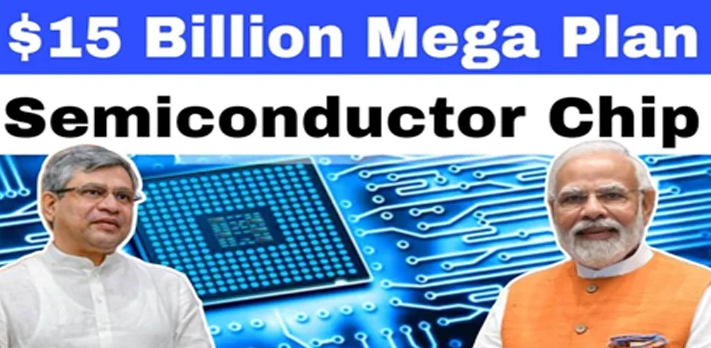India Plans USD 15 Billion for Chipmaking (GS Paper 3, Economy)

Context
- India is gearing up for a significant investment in its semiconductor industry, with a planned USD 15 billion allocation for the second phase of its chip manufacturing incentive policy under the India Semiconductor Mission.
- This follows an initial commitment of USD 10 billion for the first phase.
- The initiative is part of a broader strategy to develop a robust domestic semiconductor sector and reduce reliance on foreign technology.
Understanding Semiconductor Chips
What Are Semiconductor Chips?
- Semiconductor chips are crucial components in electronic devices, constructed from semiconductor materials such as silicon or germanium.
- These chips, often smaller than a fingernail, contain billions of microscopic switches and transistors that manage the flow of electricity to perform various functions, including data processing, information storage, and device control.
Fabrication Technology
The creation of semiconductor devices involves several complex processes:
- Wafer Preparation: Silicon wafers are prepared as the base for chip creation.
- Photolithography: Patterns are etched onto the wafer to define the chip's circuitry.
- Etching and Doping: The wafer undergoes etching to remove unwanted material and doping to introduce impurities, enhancing its electrical properties.
- Packaging: Finally, the chip is packaged to protect it and make it suitable for integration into electronic devices.
Current State of the Semiconductor Industry
Global Landscape
The semiconductor industry is currently dominated by a few key players:
- Taiwan: Home to Taiwan Semiconductor Manufacturing Company (TSMC), a leading global chip manufacturer.
- United States: The US has announced an extensive semiconductor incentive scheme with around USD 50 billion in funding.
- European Union: The EU has launched a similarly large incentive program to boost its semiconductor capabilities.
India's presence in the semiconductor sector remains minimal compared to these global leaders.
Recent Developments in India
India has made strides in enhancing its semiconductor capabilities:
- Partnerships and Agreements: India has signed agreements with countries like Singapore for chip technology and is collaborating with Taiwan’s Powerchip Semiconductor Manufacturing Corporation (PSMC) to establish its first commercial fabrication plant.
- Corporate Investments: US-based Micron Technology has committed to a Rs 22,500 crore semiconductor unit in Gujarat, aimed at enhancing India’s self-reliance in memory chip production.
Challenges Facing India’s Semiconductor Industry
High Capital Requirements
- Establishing semiconductor fabrication plants (fabs) demands substantial capital investments.
- The cost of setting up and maintaining these facilities is high, which limits domestic investment and industry growth.
Technology and Expertise Deficit
- Advanced semiconductor technology and a highly skilled workforce are essential for chip manufacturing.
- India currently lags in these areas, relying heavily on foreign technology and expertise.
Inadequate Infrastructure
- The semiconductor sector requires robust infrastructure, including a reliable power supply, water resources, and effective logistics.
- The lack of specialized industrial zones for electronics manufacturing poses additional challenges.
High Barriers to Entry
- The semiconductor industry has high entry barriers due to the advanced technology and significant investment required.
- Established players like TSMC have a competitive advantage, making it challenging for new entrants to compete.
Way Forward for India’s Semiconductor Industry
Global Collaborations and Strategic Alliances
- Strengthening bilateral and multilateral partnerships can facilitate technology transfer, joint ventures, and research collaborations.
- India’s ongoing collaborations with the US and Taiwan are steps in the right direction.
- Further engagement with South Korea, known for its advanced semiconductor technology, could also enhance India's capabilities.
Incentivizing Startups and SMEs
- Creating a supportive ecosystem for startups and small and medium-sized enterprises (SMEs) in the semiconductor space is crucial.
- Government initiatives should include funding, incubation, and mentorship programs to foster innovation and growth in the sector.
Sustainability and Green Manufacturing
- Emphasizing sustainable manufacturing practices is essential for the long-term viability of the semiconductor industry.
- This includes reducing energy and water consumption, investing in green technologies, and ensuring compliance with environmental regulations.
Conclusion
- India’s ambitious investment in the semiconductor industry signifies a strategic move towards reducing dependence on foreign technology and enhancing its domestic capabilities.
- While significant challenges remain, including high capital requirements and technological deficits, the country’s efforts to collaborate internationally and support domestic innovation position it well for future growth.
- By addressing these challenges and focusing on sustainable practices, India aims to build a robust semiconductor sector that can contribute to its technological and economic advancement.


